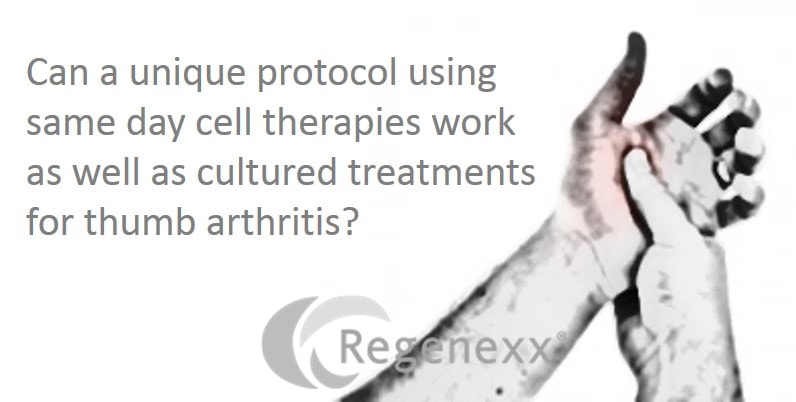The Evolution of a Thumb Arthritis Surgery Alternative: Cell Therapies Are Only a Tool
Thumb arthritis is an epidemic in our keyboard heavy and text savvy society. However, thumb arthritis in this area isn’t fully baked, leaving many patients to seek a thumb arthritis surgery alternative. In addition, our quest for an injection procedure that could replace surgery demonstrates a critical point about the future of cell therapies – for the most part, they won’t be treatments unto themselves, but tools for physicians to use to create treatments.
Our quest for a thumb arthritis surgery alternative began in 2005 when we began using culture expanded stem cells to treat arthritis in many joints. Somewhere around 2007 the first patient approached us with a thumb arthritis problem who didn’t want surgery. She was an interior designer lifting heavy samples and couldn’t take months off work. In addition, she was educated enough to understand that her surgical options weren’t fantastic. We injected her thumb joint (CMC) with cultured stem cells and eventually did the same with five other patients, all of whom did well. We then published a case series on our results.
So our experience with cultured stem cell injections and hand arthritis was very promising. However, the downsides were that this treatment was expensive and had to be performed ex-US in Grand Cayman. We then tried same day stem cells, as our knee arthritis data with this U.S. based therapy was pretty good. While we got respectable results, for this joint (unlike the knee) the thumb arthritis outcomes lagged behind what we had seen with cultured stem cells. So I went back to the drawing board. What were we missing about thumb arthritis?
The eureka moment came when we began seeing patients who had obvious mixed carpal tunnel syndrome and thumb arthritis. In these patients we treated both the arthritic thumb joint and the carpal tunnel and they did well with our very specific version of super concentrated platelet rich plasma. In addition, a patient walked in one day with the classic x-ray of someone with advanced thumb arthritis in that her joint was displaced (the top bone jutted out to the side). In looking at that patient’s joint under an ultrasound stress exam, it was obvious that it was horribly unstable with lax ligaments galore. So I combined all three concepts-joint arthritis, a smoldering nerve component that may or may not be obvious, and ligament tightening injections all using ultra-precise imaging guidance with sub-millimeter precision and a tiny 30 gauge Botox needle. How did it work?
Here’s a statement by a recent patient who loves to tinker around his local mountain home and who had severe thumb arthritis in both hands:
“My hands are definitely better than they were last October. I feel like the second round of injections really helped and I”m probably 80% improved over all at this point. The thumbs are sore after working and still feel a little fragile, or unstable at times, but they have been recovering from working usually by later the next day. Sometimes there is soreness or stiffness for no apparent reason but then the next day every thing feels good again for what ever reason.”
We’ll bring him in for a third round to get his thumbs as good as they can be before discharging him.
This evolution of how we used cell therapy for hand arthritis brings up a critical point mostly lost on the cell therapy industry. Cell therapies are simply tools and not treatments unto themselves. This is really the folly of the current regulatory approach that classifies them as drugs. Unlike an antibiotic that no matter how you give it (orally, injection into muscle, or IV) will almost always cure an infection, cells used the wrong way in the wrong protocol for the wrong condition won’t work well. We’ve seen this time and time again over our decade long experience treating orthopedic conditions with stem cells and platelets. In fact, this is the reason that many clinical trials using stem cell drugs are failing to achieve their lofty outcome endpoints.
The upshot? We’re seeing great results with same day cell therapies for thumb arthritis now that we’ve figured out the “secret sauce” of how to make them work as well as more expensive cultured stem cells. This brings up a critical point lost on many experts in regenerative medicine – cell therapies will never see their full potential until physicians learn how best to use them – which often will be long after a drug approval trial fails that used cells as a treatment. On the plus side, physicians will eventually rescue the cell therapy industry from itself, but not before a whole bunch of money is wasted!
The Regenexx-C procedure (culture expanded stem cells) is not approved by the US FDA and is only offered in countries via license where culture expanded autologous cells are permitted via local regulations.

NOTE: This blog post provides general information to help the reader better understand regenerative medicine, musculoskeletal health, and related subjects. All content provided in this blog, website, or any linked materials, including text, graphics, images, patient profiles, outcomes, and information, are not intended and should not be considered or used as a substitute for medical advice, diagnosis, or treatment. Please always consult with a professional and certified healthcare provider to discuss if a treatment is right for you.

